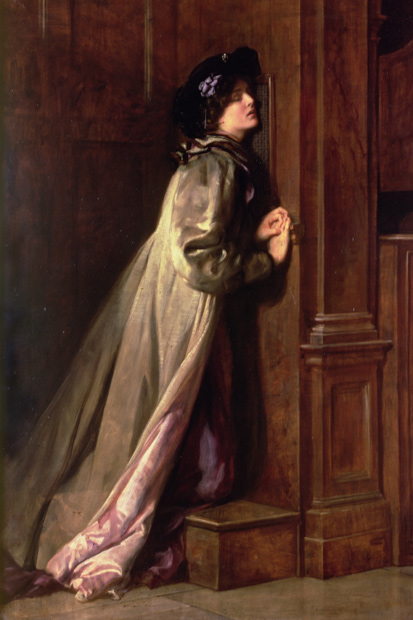I have a confession to make. I really enjoyed this book. It’s been a while since I admitted something of the sort, and I feel ashamed, because, although it’s smartly, smoothly written, my pleasure was partly based on titillation. I smirked — I occasionally snickered — at the madder facts of self-mortification, whereby in the Middle Ages the (frequently female) faithful might flaunt their holiness in acts of rank humility. Elizabeth of Hungary kissed the feet of lepers; Margaret Marie Alacoque ate vomit; Catherine of Genoa, it’s said, sucked the pus of a plague victim.
More than this, though, John Cornwell’s history of confession is preoccupied with sex, which always helps the pages riffle past. It wouldn’t be edifying, here, to recount its highlights, but let’s just say that, for anyone into clerical action, there’s a lot on offer. The emphasis is on couplings occurring during, or soon after, the sacrament. It isn’t astonishing that this has been a problem, since the confessional exchange is by its nature erotic, involving intimacy and a power imbalance. One missed trick, I’d say, is that the author doesn’t consider how the design of the confessional box also contributes, with its (for the penitent) dark, enclosed space, its grille and sliding screen, and of course the partition itself. Nothing gets the blood flowing like a barrier, especially if there’s a chink or crack (think Pyramus and Thisbe), through which words may grow aphrodisiac, stirring the imagination into brilliant overdrive.
I’m getting carried away, but so does Cornwell. And he would make a similar defence, pointing out that the reason why The Dark Box (his sizzling title) dwells on such matters is because they’ve always been an obsession in the Church. The tone, often, has been one of swivel-eyed craziness. When the first-century lawyer and Christian thinker Tertullian asked if we didn’t sense, in orgasm, the loss of our souls, someone should have replied: speak for yourself, Tertullian. A large clitoris is not now generally thought to be a proof of lesbianism. And if it were really true, as priests once taught, that masturbation was a kind of multiple murder — because each sperm contains a human life — all I can say is there were a few guys I knew at school who should be on trial at the Hague.
It’s easy to make jokes, and Cornwell resists the temptation admirably. He tells his central story soberly and well, of how private confession arose out of the much older practice of public penance. For centuries, the penitent knelt at the seated confessor’s feet. Then, in 1576, Archbishop Charles Borromeo introduced the box to the duomo in Milan: a divided cabinet, to protect women from priestly molestation. Fast-forward to 1910, and Pope Pius X radically altered the practice by advocating far more frequent confession, and lowering the age of first confession to seven.
If the author were honest, I think, he’d have to confess that his primary aim in this book is not to sketch out a simple history of his subject but to prove a link between that 1910 reform and the rise in reported instances of child abuse by priests. In an English seminary in his teens, he was himself propositioned by a priest during confession, so he knows what he’s talking about.
Equally, you might say, it wouldn’t be surprising if, after that traumatic experience, Cornwell were to overstate what he calls the ‘systemic connection between confession, the confessional oppression of children, and clerical sexual abuse of children’. Clearly, the sacrament of confession gives an opportunity for a priest with paedophilic urges to speak to children about sex. But the author wants satisfaction, it seems, and not only in the orthodox sense of a reconciliation with God.
You can’t argue with this anger. You shouldn’t. And I’m grateful to Cornwell for a book which, titbits aside, must have been tough at times to write, and is always instructive to read. I’d add, though, that it would have been more instructive, and even more welcome, if he’d also used his articulacy, fortified by his expertise, to acknowledge the virtues of the Christian life at its best (I say this as an atheist), and to consider the benefits of confession properly carried out.
We live in an age when the boundaries between public and private have been practically annihilated, when people tweet their bons mots, blog about their brilliance and post pictures of themselves having a good time while the good time is still going on. In that context, the idea of anyone dissatisfied with their behaviour, interested in improving and quietly sharing this with someone whose principles they admire and discretion they trust, seems, in principle at least, a pretty dignified one. I hope John Cornwell will forgive me for saying that.






Comments